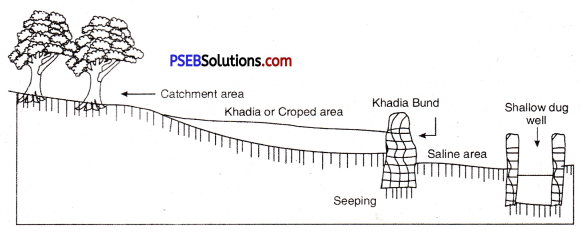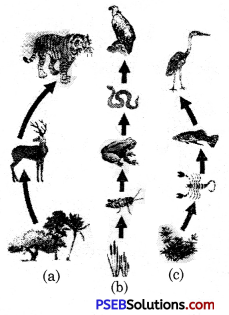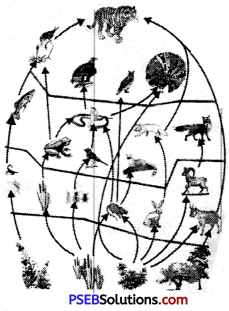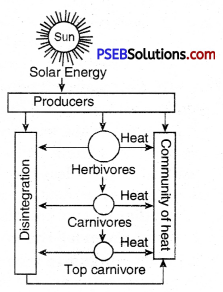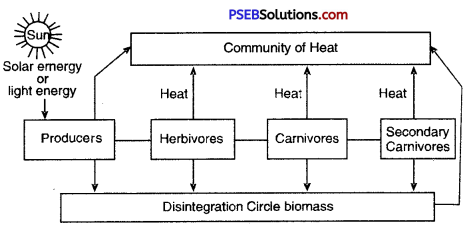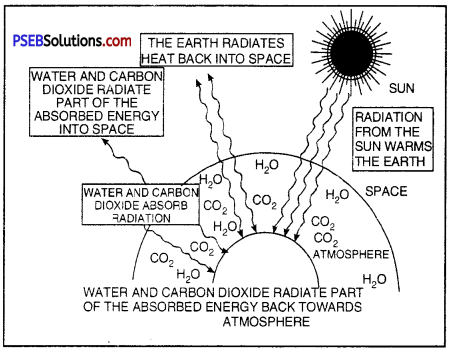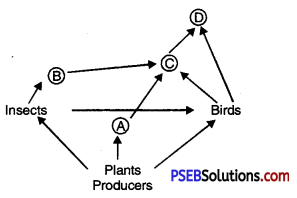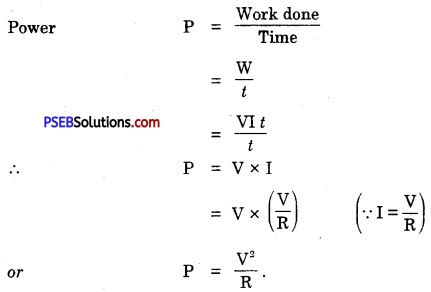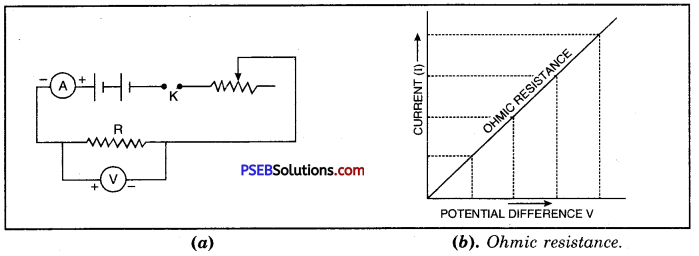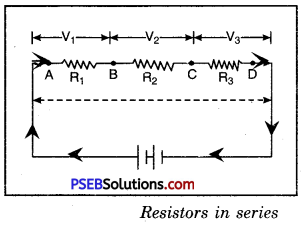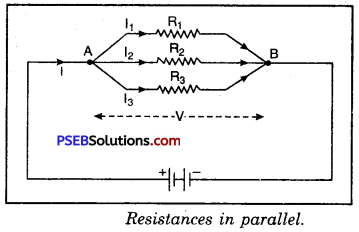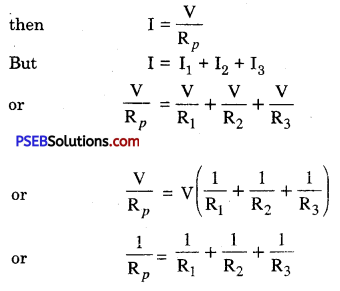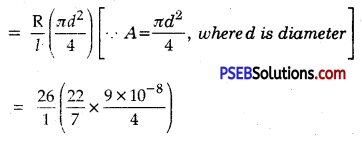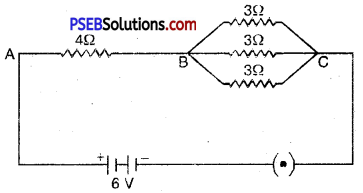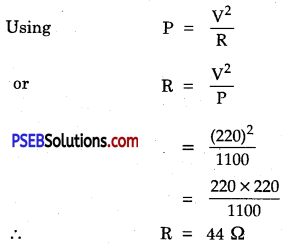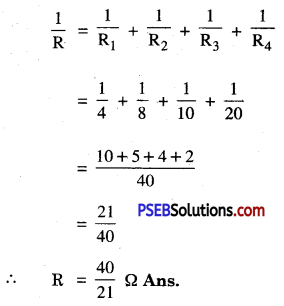Punjab State Board PSEB 10th Class Hindi Book Solutions Chapter 13 मैं और मेरा देश Textbook Exercise Questions and Answers.
PSEB Solutions for Class 10 Hindi Chapter 13 मैं और मेरा देश
Hindi Guide for Class 10 PSEB मैं और मेरा देश Textbook Questions and Answers
(क) विषय बोध
I. निम्नलिखित प्रश्नों के उत्तर एक या दो पंक्तियों में दीजिए
प्रश्न 1.
लेखक को अपनी पूर्णता का बोध कब हुआ?
उत्तर:
जब लेखक को यह पता चला कि उसे अनेक की अपने लिए ज़रूरत पड़ती है और वह भी अनेक की ज़रूरतें पूरी करता है तो उसे अपनी स्थिति की पूर्णता का बोध हुआ।
प्रश्न 2.
मानसिक भूकंप से क्या अभिप्राय है?
उत्तर:
मानसिक विचारों और विश्वासों में हलचल उत्पन्न होना मानसिक भूकंप होता है, जिससे मन में अनेक विचार आंदोलित होने लगते हैं।
![]()
प्रश्न 3.
किस तेजस्वी पुरुष के अनुभव ने लेखक को हिला दिया?
उत्तर:
स्वर्गीय पंजाब केसरी लाला लाजपतराय के विदेश यात्रा के दौरान भारतवर्ष की गुलामी की लज्जा के कलंक के अनुभव ने लेखक को हिला दिया।
प्रश्न 4.
मनुष्य के लिए संसार के सारे उपहारों और साधनों को व्यर्थ क्यों कहा?
उत्तर:
नुष्य के लिए संसार के सभी उपहार और साधन तब व्यर्थ हो जाते हैं जब उसका देश गुलाम हो या किसी भी अन्य रूप से हीन होता है।
प्रश्न 5.
युद्ध में ‘जय’ बोलने वालों का क्या महत्त्व है?
उत्तर:
युद्ध क्षेत्र में लड़ने के अतिरिक्त जय बेलने वाले सैनिकों का साहस बढ़ाने का कार्य करते हैं। इससे उनका उत्साह बढ़ता है।
प्रश्न 6.
दर्शकों की तालियाँ खिलाड़ियों पर क्या प्रभाव डालती हैं?
उत्तर:
दर्शकों की तालियाँ मैदान में खेलने वाले खिलाड़ियों के उत्साह को बढ़ाती हैं। उत्साह के बढ़ने से वो अधिक अच्छा और जोश से भर कर जीत के लिए खेलते हैं।
प्रश्न 7.
जापान के स्टेशन पर स्वामी रामतीर्थ क्या ढूंढ़ रहे थे?
उत्तर:
जापान के स्टेशन पर स्वामी रामतीर्थ फल ढूंढ़ रहे थे।
प्रश्न 8.
कमालपाशा कौन थे?
उत्तर:
कमालपाशा तुर्की के राष्ट्रपति थे।
प्रश्न 9.
बूढ़े किसान ने कमालपाशा को क्या उपहार दिया?
उत्तर:
बूढ़े किसान ने कमालपाशा को मिट्टी की छोटी-सी हाँडी में पाव-भर शहद का उपहार दिया था।
प्रश्न 10.
किसान ने पंडित जवाहर लाल नेहरू को क्या उपहार दिया?
उत्तर;
किसान ने पंडित नेहरू को रंगीन सुतलियों से बुनी खाट उपहार में दी।
प्रश्न 11.
लेखक के अनुसार हमारे देश को किन दो बातों की आवश्यकता है?
उत्तर:
लेखक के अनुसार हमारे देश को शक्ति बोध और सौंदर्य बोध इन दो बातों की आवश्यकता है।
प्रश्न 12.
शल्य कौन था?
उत्तर:
शल्य महाबली कर्ण का सारथि, माद्री का भाई, मद्रय देश का राजा तथा नकुल-सहदेव का मामा था।
II. निम्नलिखित प्रश्नों के उत्तर तीन या चार पंक्तियों में दीजिए
प्रश्न 1.
लाला लाजपतराय के किस अनुभव ने लेखक की पूर्णता को अपूर्णता में बदल दिया?
अथवा
‘मैं और मेरा देश’ निबन्ध के आधार पर लिखें कि लाला लाजपतराय के किस अनुभव ने लेखक की पूर्णता को अपूर्णता में बदल दिया?
उत्तर:
लाला लाजपतराय संसार के अनेक देशों में घूमने गए थे। जब वे वहाँ से घूम कर अपने देश में लौटे तो उन्होंने अपना विदेशी यात्रा का अनुभव सुनाते हुए कहा कि वे अमेरिका, इंग्लैंड, फ्रांस तथा संसार के दूसरे जिन देशों में भी गए उन पर भारतवर्ष की गुलामी की लज्जा का कलंक लगा ही रहा। उनके इस अनुभव ने लेखक की पूर्णता को अपूर्णता में बदल दिया था।
![]()
प्रश्न 2.
स्वामी रामतीर्थ द्वारा फलों की टोकरी का मूल्य पूछने पर जापानी युवक ने क्या कहा?
उत्तर:
स्वामी रामतीर्थ के मुख से यह सुनकर कि जापान में शायद अच्छे फल नहीं मिलते। एक जापानी युवक एक टोकरी ताज़ा फल स्वामी जी को भेंट करते हुए कहता है कि लीजिए ताजे फल। स्वामी जी ने जब उसे फलों का मूल्य देना चाहा तो उसने मना किया और कहा कि आप इनका मूल्य देना ही चाहते हैं तो अपने देश में जाकर किसी से यह न कहिएगा कि जापान में अच्छे फल नहीं मिलते।
प्रश्न 3.
किसी देश के विद्यार्थी ने जापान में ऐसा कौन-सा काम किया जिससे उसके देश के माथे पर कलंक का टीका लग गया?
उत्तर:
किसी देश का कोई युवक जापान में शिक्षा लेने आया। वह सरकारी पुस्तकालय में पुस्तक पढ़ने लगा। उसने उस पुस्तक में से कुछ चित्र फाड़ लिए और पुस्तक वापस कर आया। किसी जापानी युवक ने इसकी शिकायत की और पुस्तकालय के अधिकारी को सूचित कर दिया। पुलिस ने तलाशी लेकर वे चित्र उस विद्यार्थी से बरामद कर लिए और उसे जापान से निकाल दिया। साथ ही उन्होंने पुस्तकालय के नोटिस-बोर्ड पर लिखवा दिया कि जिस देश का वह विद्यार्थी था उस देश का कोई भी निवासी इस पुस्तकालय में प्रवेश नहीं कर सकता। इस प्रकार उस युवक के इस काम से उसके देश के माथे पर कलंक का टीका लगा।
प्रश्न 4.
लेखक के अनुसार कोई भी कार्य महान् कैसे बन जाता है?
उत्तर:
महत्त्व किसी कार्य की विशालता में नहीं होता, महत्त्व सदा उस कार्य को करने की भावना में होता है। लेखक के अनुसार यदि कोई बड़े से बड़ा कार्य अच्छी भावना से न किया जाए तो वह कार्य हीन होता है। इसके विपरीत अच्छी भावना से किया गया छोटे-से-छोटा कार्य भी महान् होता है।
प्रश्न 5.
शल्य ने कौन-सा महत्त्वपूर्ण कार्य किया? पाठ के आधार पर लिखिए।
उत्तर:
कर्ण का सारथि बन कर शल्य कर्ण के सम्मुख अर्जुन की अजेयता का बार-बार उल्लेख करता रहता था। इससे कर्ण के आत्मविश्वास में कमी आ गई जिससे बाद में वह अर्जुन से पराजित हो गया था। कर्ण जब भी अपने पक्ष की विजय से प्रसन्न होता, शल्य की अर्जुन की प्रशंसा उसे अपने पक्ष की हीनता का बोध कराती थी।
प्रश्न 6.
शक्ति-बोध और सौंदर्य-बोध से क्या तात्पर्य है? पाठ के आधार पर बताइए।
उत्तर:
शक्ति-बोध का अर्थ देश को शक्तिशाली बनाने से और सौंदर्य-बोध का अर्थ देश को सुंदर बनाने से है। लेखक शक्ति-बोध को स्पष्ट करते हुए कहता है कि यदि हम सार्वजनिक स्थलों पर अपने देश की बुराई करते हैं तथा अपने देश को हीन और दूसरे देशों को अपने देश से श्रेष्ठ बताते हैं तो इससे हमारे देश के शक्ति-बोध को चोट पहुँचती है। इसी प्रकार से सौंदर्य-बोध को स्पष्ट करते हुए लेखक कहता है कि जब हम अपने घर, मुहल्ले, गलियों, सार्वजनिक स्थलों आदि को गंदा रखते हैं तो हम अपने देश के सौंदर्य-बोध को क्षति पहुँचाते हैं।
प्रश्न 7.
हम अपने देश के शक्तिबोध को किस प्रकार चोट पहुंचाते हैं?
उत्तर:
जब हम रेलों, मुसाफिरखानों, क्लबों, चौपालों आदि सार्वजनिक स्थानों पर अपने देश की ख़ामियों का वर्णन करते हैं, दूसरे देशों की खुशहाली की प्रशंसा करते हैं, अपने देश की दयनीय दशा का वर्णन करते हैं, अपने देश को हीन तथा दूसरे देशों को श्रेष्ठ बताते हैं तो हम अपने देश के शक्ति-बोध को चोट पहुँचाते हैं। इससे हम स्वयं ही अपने देश के सामूहिक मानसिक बल को भी हीन कर देते हैं। हम अपने देश को तुच्छ तथा अन्य देशों को उच्च मानने लगते हैं।
प्रश्न 8.
हम अपने देश के सौंदर्य बोध को किस प्रकार चोट पहुंचाते हैं?
उत्तर:
जब हम अपने देश के प्रत्येक ऐसे स्थान को साफ-स्वच्छ नहीं रखते तो हम देश के सौंदर्य बोध को चोट पहुंचाते हैं। हमें अपना घर मुहल्ला, गली, गाँव, नगर आदि सभी की सफाई-स्वच्छता की ओर ध्यान देना चाहिए। यदि हमारा परिवेश गंदा रहेगा तो हमारे सौंदर्य बोध को धक्का लगेगा। सौंदर्य बोध हमारे मन-मस्तिष्क के साथ-साथ सोच पर भी आधारित होता है।
प्रश्न 9.
देश की उच्चता और हीनता की कसौटी क्या है?
उत्तर:
देश की उच्चता और हीनता की कसौटी ‘चुनाव’ है। जिस देश के लोग यह समझते हैं कि चुनाव में किसे अपना मत देना चाहिए और किसे नहीं देना चाहिए-वह देश उच्च है। जिस देश के नागरिक झूठे-उत्तेजक नारों या व्यक्तियों के गलत प्रभाव से अपना मत देते हैं, वे हीन हैं। उच्चता और हीनता की कसौटी ही किसी जाति और देश को ऊँचा उठाती है।
III. निम्नलिखित प्रश्नों के उत्तर छः या सात पंक्तियों में दीजिए
प्रश्न 1.
लाला लाजपतराय जी ने देश के लिए कौन-सा महत्त्वपूर्ण कार्य किया? निबंध के आधार पर उत्तर दीजिए।
उत्तर:
लाला लाजपत राय देश के स्वतंत्रता सेनानियों में से प्रमुख थे। उन्होंने देश की पराधीन स्थिति पर चिंता व्यक्त करते हुए अनेक लेख लिखे थे। वे अपनी ओजस्वी वाणी द्वारा भारतीयों में गुलामी के विरुद्ध लड़ने के लिए जोश भर देते थे। उनका व्यक्तित्व अपूर्व था। जो भी उनसे मिलता था, प्रभावित हो जाता था। उन्होंने अमेरिका, इंग्लैंड, फ्रांस आदि की यात्राएं की थीं। वे इस बात से दु:खी थे कि विदेशों में यात्रा करते समय उन पर भारतवर्ष की गुलामी की लज्जा का कलंक लग रहा था। उन्होंने भारतवासियों को इस कलंक से मुक्त होने के लिए प्रेरित किया।
प्रश्न 2.
तुर्की के राष्ट्रपति कमालपाशा और भारत के प्रधानमंत्री पंडित जवाहर लाल नेहरू से संबंधित घटनाओं द्वारा लेखक क्या संदेश देना चाहता है?
उत्तर:
तुर्की के राष्ट्रपति कमालपाशा को उसकी वर्षगांठ के अवसर पर एक बूढ़ा किसान मिट्टी की हाँडी में पावभर शहद देता है, जिसे कमालपाशा ने उसी समय शहद को चाटकर किसान को कहा कि यह तो तुम्हारा सर्वोत्तम उपहार है। इसी प्रकार से प्रधानमंत्री जवाहर लाल नेहरू को एक किसान ने रंगीन सुतलियों से बुनी खाट भेंट की, तो उसे देखकर पंडित जी भाव-विभोर हो गए थे। इन दोनों उपहारों में भेंटकर्ता के हृदय का शुद्ध प्यार झलक रहा था। इन घटनाओं से लेखक यह सिद्ध करना चाहता है कि अच्छी भावना से किया गया छोटे से छोटा कार्य भी महान् होता है। इन दोनों ने अपना-अपना उपहार हृदय की शुद्ध भावना से दिया था, इसलिए इन की छोटी-सी भेंट भी अत्यंत मूल्यवान हो गई।
![]()
प्रश्न 3.
लेखक ने देश के नागरिकों को चुनाव में किन बातों की ओर ध्यान देने के लिए कहा है?
उत्तर:
देश के प्रत्येक नागरिक को अपने मताधिकार का सही रूप से प्रयोग करना चाहिए। मत का प्रयोग करते समय यह ध्यान रखना चाहिए कि मत सही व्यक्ति को दिया जा रहा है। किसी के गलत प्रभाव में आकर किसी गलत व्यक्ति को मत देना उचित नहीं है। हमें व्यक्ति विशेष के गुण-दोषों को विचार कर ही मतदान करना चाहिए। किसी प्रकार के लालच में आकर मतदान नहीं करना चाहिए।
(ख) भाषा-बोध
I. निम्नलिखित शब्दों से भाववाचक संज्ञा बनाइए:
मनुष्य, ऊँचा, पूर्ण, लड़ना, स्वतंत्र, गुलाम, उच्च, व्यक्ति, हीन, पुरुष।
उत्तर:
शब्द = भाववाचक संज्ञा
मनुष्य = मनुष्यता
ऊँचा = ऊँचाई
पूर्ण = पूर्णता
लड़ना = लड़ाई
स्वतंत्र = स्वतंत्रता
गुलाम = गुलामी
उच्च = उच्चता
व्यक्ति = व्यक्तित्व
पुरुष = पौरुष
हीन = हीनता
II. निम्नलिखित शब्दों के विशेषण शब्द बनाइए
नगर, राष्ट्र, संसार, भारत, संस्कृति, दया, परिवार, घर।
उत्तर:
शब्द = विशेषण
नगर = नागरिक
राष्ट्र = राष्ट्रीय
संसार = सांसारिक
भारत = भारतीय
संस्कृति = सांस्कृतिक
दया = दयालु
परिवार = पारिवारिक
घर = घरेलू
III. निम्नलिखित शब्दों के विपरीत शब्द लिखिए:
ज्ञान, लाभ, अंधकार, सफल, जीवन, पराजय, साधारण, पक्ष, स्वतंत्र, सम्मान।
उत्तर:
शब्द – विपरीत शब्द
ज्ञान – अज्ञान
लाभ – हानि
अंधकार – उजाला
सफल – विफल
जीवन – मृत्यु
पराजय – विजय
साधारण – असाधारण
पक्ष – विपक्ष
स्वतंत्र – परतंत्र
सम्मान – अपमान
(ग) रचनात्मक अभिव्यक्ति
प्रश्न 1.
आप अपने देश के सम्मान और गरिमा को बनाए रखने में क्या योगदान दे सकते हैं? स्पष्ट कीजिए।
उत्तर:
अपने देश का गौरव बढ़ाने के लिए हमें ऐसा कोई कार्य नहीं करना चाहिए जिससे हमारे देश की स्वतंत्रता और सम्मान को ठेस पहँचे। सार्वजनिक स्थलों पर कभी भी अपने देश को हीन तथा अन्य देशों को श्रेष्ठ नहीं बताना चाहिए। अपने घर, गली, सार्वजनिक स्थलों पर गंदगी नहीं फैलानी चाहिए। जब भी कोई चुनाव हो हमें अपना मत योग्य व्यक्ति को देना चाहिए। कभी भी किसी गलत प्रलोभन में आकर किसी गलत व्यक्ति को मत नहीं देना चाहिए।
प्रश्न 2.
हम सभी अपने देश से जुड़े हैं। हमारे अच्छे और बुरे कार्यों का प्रभाव देश पर पड़ता है। इस सन्दर्भ में अपने अध्ययन और अनुभव के आधार पर किसी घटना का वर्णन करें।
उत्तर:
एक दिन मैं अपने पिता जी की आज्ञा के बिना उनका मोटर साइकिल लेकर ऐसे ही घूमने निकल गया। मेरे पास वाहन चलाने का लाइसैंस नहीं है। मैं अभी सोलह वर्ष का हूँ। मैंने सिर पर हैलमेट भी नहीं पहना था। चौराहे पर मुझे एक पुलिस वाले ने रोक लिया और मेरा चालान काटने लगा। मैं गिड़गिड़ाने लगा और अपनी जेब में रखा हुआ सौ का नोट उसे देकर पीछा छुड़ाया। यहीं से मैं घर लौट आया। जब मैंने सोचा तो मुझे लगा कि मैंने बुरा कार्य किया है। रिश्वत दी है तथा भ्रष्टाचार को अपनाया है। जो देश के साथ मैंने धोखा दिया। भविष्य में ऐसा कुछ न करने का मैंने प्रण किया।
प्रश्न 3.
आप अपने विद्यालय में शक्ति-बोध और सौंदर्य बोध कैसे ला सकते हैं? इस विषय पर कक्षा में चर्चा कीजिए।
उत्तर:
हम अपने विद्यालय में देश-प्रेम, स्वदेश भक्ति, सत्यनिष्ठा, दृढ़ता, उदारता आदि भावों का प्रचार कर शक्तिबोध तथा विद्यालय परिसर को साफ़-सुथरा रख कर सौंदर्य बोध ला सकते हैं।
प्रश्न 4.
सार्वजनिक संपत्ति की सुरक्षा हम सब कैसे करें। इस विषय पर कक्षा में चर्चा कीजिए।
उत्तर:
सार्वजनिक संपत्ति की हमें उसी प्रकार से सुरक्षा करनी चाहिए जैसी सुरक्षा हम अपने घर तथा अपनी वस्तुओं की करते हैं। इस विषय पर विद्यार्थी अपने साथियों से चर्चा कर लिखें।
(घ) पाठ्येतर सक्रियता
1. लाला लाजपतराय के जन्मदिन और पुण्यतिथि पर इनके बारे में अपने विचार विद्यालय की प्रार्थना सभा में प्रस्तुत करें। (विद्यार्थी स्वयं करें)
2. ‘अकेला चना क्या भाड़ फोड़ेगा’ कहावत को शत प्रतिशत झूठ सिद्ध करने वाले देश भक्तों/महान् पुरुषों के चित्र एकत्रित कर कक्षा-पत्रिका तैयार कीजिए।
निम्नलिखित प्रेरक-प्रसंगों का कक्षा में मंचन कीजिए
- स्वामी रामतीर्थ और जापानी युवक का प्रसंग।
- पंडित जवाहर लाल नेहरू और किसान का प्रसंग।
- तुर्की के राष्ट्रपति और बूढ़े किसान का प्रसंग।।
- कर्ण और शल्य का प्रसंग।
(ङ) ज्ञान-विस्तार
भामाशाह- भामाशाह अत्यंत देशभक्त थे। वे मेवाड़ के शासक महाराणा प्रताप के छुटपन से ही मित्र थे। उनके पास बहुत अधिक धन-दौलत थी जिसे उन्होंने अपने देश मेवाड़ के लिए महाराणा प्रताप को सौंप दी थी। उसी धन से प्रताप ने अपनी सेना का पुनर्गठन कर के मुगल शासकों को हराकर अपना मेवाड़ पुनः प्राप्त कर लिया था।
कर्ण-महाभारत काल में कर्ण का नाम सर्वोपरि है। उसकी माँ कुंती थी लेकिन कारण वश उसका पालन-पोषण उसने नहीं किया था। कर्ण दुर्योधन का अच्छा मित्र था और उसने उसी के पक्ष में रह कर अपने पांडव भाइयों के विरुद्ध लड़ाई लड़ी थी। वह महान् दानी था और उसे सूर्य का पुत्र माना जाता है। सूर्य पुत्र होने के कारण ही उसे जन्मजात कवच-कुंडल प्राप्त हुए थे।
शल्य-शल्य पांडु के सगे साले थे और वे शल्य माद्रा के शासक थे। वे नकुल और सहदेव के मामा थे लेकिन इन्होंने महाभारत के युद्ध में पांडवों का साथ नहीं दिया था। ये युद्ध भूमि में कर्ण के सारथी बने थे और बाद में युधिष्ठिर के हाथों युद्ध के अंतिम दिन मारे गए थे।
चेखोव-ये रूस के अत्यंत प्रसिद्ध चिकित्सक, कथासार और नाटककार थे। इनका पूरा नाम एंटोन पाब्लोविच चेखोव था। इन्होंने लेखन कार्य करने के साथ-साथ सफलतापूर्वक चिकित्सा कार्य को भी निभाया था। वे मानते थे कि ‘चिकित्सा’ उनकी पत्नी थी और ‘साहित्य’ प्रेमिका।
कमालपाशा-कमालपाशा का पूरा नाम ‘अतातुर्क उर्फ मुस्तफ़ा कमालपाशा’ था। इनका काल 1881 से 1938 तक माना जाता है। आधुनिक तुर्की का वास्तविक विकास इन्होंने ही किया था। इन्होंने अपने समय के साम्राज्यवादी शासक सुल्तान अब्दुल हमीद द्वितीय को सिंहासन से हटा देने में सफलता प्राप्त की थी। उन्होंने अपने देश का चहुंमुखी विकास करने में पूरी तरह से सफलता प्राप्त की थी।
![]()
PSEB 10th Class Hindi Guide मैं और मेरा देश Important Questions and Answers
प्रश्न 1.
युद्ध क्षेत्र में लड़ने के अतिरिक्त एक नागरिक और क्या कार्य कर सकता है?
उत्तर:
अपना-अपना कार्य ठीक प्रकार से करें। किसान खेती ठीक से करें जिससे लड़ने वालों को रसद पहुँच सके।
प्रश्न 2.
युद्ध में “जय” बोलने वालों का क्या महत्त्व है?
उत्तर:
युद्ध में “जय” बोलने वालों का बहुत महत्त्व है। इससे युद्ध लड़ने वालों को प्रोत्साहन मिलता है और वे नये जोश से युद्ध करने लगते हैं।
प्रश्न 3.
दर्शकों की तालियाँ खिलाड़ियों पर क्या प्रभाव डालती हैं?
उत्तर:
दर्शकों की तालियाँ खिलाड़ियों में नया जोश भर देती हैं। उनके पैरों में बिजली भर जाती है और हारते हुए खिलाड़ी भी जीत जाते हैं।
प्रश्न 4.
कवि-सम्मेलनों और मुशायरों की सफलता किस बात पर निर्भर करती है ?
उत्तर:
कवि-सम्मेलनों और मुशायरों की सफलता दाद देने वालों पर निर्भर करती है। जिस कवि को अधिक दाद मिलती है, वह अधिक सफल माना जाता है।
प्रश्न 5.
कमालपाशा की घटना के द्वारा लेखक क्या बताना चाहता है ?
उत्तर:
कमालपाशा की घटना के द्वारा लेखक यह बताना चाहता है कि प्यार से दिया हुआ छोटा-सा उपहार भी अनमोल होता है। कमालपाशा की वर्षगांठ के अवसर पर उत्सव की समाप्ति के बाद एक देहाती बूढ़ा उन्हें उपहार देने आया। सैक्रेटरी ने बूढ़े से कहा कि समय बीत चुका है। बूढ़े के कहने पर कमालपाशा को सूचना भेजी गयी। उन्होंने आदर से बूढ़े किसान को बुलाया और उसके द्वारा लायी गई मिट्टी की हांडी में पाव-भर शहद के उपहार को स्वयं खोला और शहद चाटकर कहा कि सर्वोत्तम उपहार तुम्हारा ही है क्योंकि इसमें तुम्हारे हृदय का शुद्ध प्यार है।
प्रश्न 6.
एक किसान और पंडित जवाहर लाल नेहरू के बीच घटित घटना का उल्लेख करें।
उत्तर:
एक किसान रंगीन सुतलियों से बुनी खाट प्रधानमंत्री पंडित नेहरू को देने उनकी कोठी पर पहुँचा। पंडित . जी कोठी से बाहर आए तो वह खाट उसने पंडित जी को दे दी। पंडित जी को देख कर वह भाव-विभोर हो गया तो पंडित जी ने उससे पूछा कि वह क्या चाहता है? उसने कहा कि यह उपहार स्वीकार करें। पंडित नेहरू ने उस का यह उपहार प्यार से स्वीकार किया तथा अपनी एक फोटो पर दस्तखत करके उसे दे दी।
प्रश्न 7.
लेखक के आनंद की दीवार में दरार क्यों पड़ गयी?
उत्तर:
लेखक के आनंद की दीवार में दरार इसलिए पड़ गयी थी कि उसे पता चला कि उसकी स्थिति बहुत हीन हो गई है। उसका कहीं भी कोई भी अपमान कर सकता है। वह उस अपमान के लिए बदला लेना तो दूर, उसके लिए कहीं अपील या दया की प्रार्थना भी नहीं कर सकता क्योंकि वह एक गुलाम देश का नागरिक है।
प्रश्न 8.
लेखक की छटपटाहट का क्या कारण था?
उत्तर:
लेखक की छटपटाहट का कारण यह था कि यदि किसी मनुष्य के पास संसार के ही नहीं, यदि स्वर्ग के भी सब उपहार और साधन हों, पर उस का देश गुलाम हो या किसी भी दूसरे रूप से हीन हो, तो वे सारे उपहार और साधन उसे गौरव नहीं दे सकते। यह सोच कर उसका मन विभिन्न विचारों से छटपटाने लगा था।
प्रश्न 9.
लेखक ने जीवन को एक युद्ध क्यों कहा है?
उत्तर:
लेखक जीवन को एक युद्ध मानता है। वह युद्ध लड़ना ही युद्ध नहीं मानता है। उसके विचार में लड़ने वालों तक रसद पहुँचाना भी युद्ध लड़ने के समान है। इसके लिए किसानों को ठीक प्रकार से खेती करनी चाहिए। साथ युद्ध करने वालों की जय-जयकार भी करनी चाहिए। इससे युद्ध करने वालों की हिम्मत बढ़ती है।
प्रश्न 10.
हम अपने देश के सौंदर्य-बोध को किस प्रकार चोट पहुंचाते हैं?
उत्तर:
रास्ते में केले के छिलके फेंककर, अपने घर का कूड़ा बाहर फेंक कर, गन्दी बातें करके, सार्वजनिक स्थानों जैसे धर्मशाला, होटल आदि में थूक कर, उत्सव, समारोह आदि में धक्का-मुक्की करके, कहीं समय देकर वहाँ समय पर न पहुँच कर, अपने घर, दफ्तर, गली आदि को गन्दा रख कर हम देश के सौंदर्य-बोध को चोट पहुंचाते हैं।
एक पंक्ति में उत्तरात्मक प्रश्न
प्रश्न 1.
लेखक बड़ा कैसे हुआ?
उत्तर:
लेखक अपने पड़ोस में खेल कर तथा पड़ोसियों की ममता-दुलार पाकर बड़ा हुआ था।
प्रश्न 2.
लाला लाजपतराय को किस बात की लज्जा थी?
उत्तर:
उन्हें इस बात की लज्जा थी कि भारतवर्ष की गुलामी का कलंक उनके माथे पर लगा है।
![]()
प्रश्न 3.
स्वामी रामतीर्थ कहाँ गए थे?
उत्तर:
स्वामी रामतीर्थ जापान गए थे।
प्रश्न 4.
चुनाव के समय प्रत्येक नागरिक का क्या कर्त्तव्य है?
उत्तर:
उसे सही व्यक्ति को अपना मत देना चाहिए।
बहुवैकल्पिक प्रश्नोत्तर निम्नलिखित प्रश्नों के उत्तर एक सही विकल्प चुनकर लिखें
प्रश्न 1.
एक दिन किसकी दीवार में दरार पड़ गई
(क) संबंधों की
(ख) मित्रों की
(ग) आनन्द की
(घ) घर की।
उत्तर:
(ग) आनन्द की
प्रश्न 2.
भूकंप कहाँ उठा था?
(क) मानस में
(ख) रास्ते में
(ग) पहाड़ों में
(घ) संबंधों में।
उत्तर:
(क) मानस में
प्रश्न 3.
किसान पंडित नेहरू को उपहार में देने के लिए क्या लाया था
(क) शहद
(ख) खाट
(ग) चटाई
(घ) कुर्सी।
उत्तर:
(ख) खाट
एक शब्द/हाँ-नहीं/सही-गलत/रिक्त स्थानों की पूर्ति के प्रश्न
प्रश्न 1.
वह देश कैसा है जिस देश के नागरिक यह समझते हैं कि चुनाव में किसे मत देना चाहिए और किसे नहीं? (एक शब्द में उत्तर दें)
उत्तर:
उच्च
प्रश्न 2.
कमालपाशा ईरान के राष्ट्रपति थे। (सही या गलत लिखकर उत्तर दें)
उत्तर:
गलत
प्रश्न 3.
युद्ध में जय बोलने वालों का भी महत्त्व है। (सही या गलत लिखकर उत्तर दें)
उत्तर:
सही
प्रश्न 4.
मैं अपने नगर के लोगों का सम्मान करता था, वे मेरा सम्मान नहीं करते थे। (हाँ या नहीं में उत्तर लिखें)
उत्तर:
नहीं
प्रश्न 5.
मैं अपने घर में जन्मा था, पला था। (हाँ या नहीं में उत्तर लिखें)
उत्तर:
हाँ
प्रश्न 6.
एक ………… पुरुष का …………. ही वह भूकंप था।
उत्तर:
तेजस्वी, अनुभव
प्रश्न 7.
एक …………. युवक …………….. पर खड़ा था।
उत्तर:
जापानी, प्लेटफार्म
प्रश्न 8.
राष्ट्रपति ……………… उसकी ………….. भेजी गई।
उत्तर:
तक, सूचना।
मैं और मेरा देश कठिन शब्दों के अर्थ
संपर्क = मेल-जोल। संचित = एकत्र किया हुआ। सम्मान = इज्ज़त। अपूर्णता = कमी। आनंद = खुशी, प्रसन्नता। अपूर्व = अनोखा। मानसिक = मन से सम्बन्धित। मानस = मन। पराधीनता = गुलामी। भौंचक्का = हैरान। उत्तेजना = प्रेरणा-वेगों को तीव्र करना। रसद = भोजन, खाने पीने की वस्तुएँ। दाद देना = तारीफ़ करना, प्रशंसा करना। साक्षी = गवाह। आग्रह = अनुरोध। सर्वोत्तम = सबसे अच्छा। ह्रास = गिरावट। अजेयता = जो जीता न जा सके। सघन = बहुत अधिक घना। सुरुचि = अच्छी पसन्द। संगठित = एकत्रित, जोड़ा हुआ। तुच्छ = नगण्य। भूकंप = भूचाल। बवंडर = आँधी-तूफ़ान। ठसक = अभिमान, गर्व। कसक = रुक-रुक कर होने वाली पीड़ा, टीस। लज्जा = शर्म, लाज। गौरव = आदर, सम्मान। धनिक = धनवान व्यक्ति। मुशायरों = उर्दू, फ़ारसी का कवि सम्मेलन। साक्षी = गवाही देने वाला। दुर्लभ = कठिनता से प्राप्त होने वाली। हीन = तुच्छ, नगण्य। लांछित = कलंकित। विश्राम = आराम। हंडिया = एक तरह की मिट्टी का बर्तन। निहाल = प्रसन्न एवं संतुष्ट। खाट = चारपाई। दस्तखत = हस्ताक्षर। विवरण = व्याख्या। कसौटी = परख, जाँच। संदेह = शंका। तरेड़ = दरार। जीनों में = सीढ़ियों में। ठेलम-ठेल = धक्कम धक्का।
![]()
मैं और मेरा देश लेखक परिचय
शरी कन्हैया लाल मिश्र ‘प्रभाकर’ आधुनिक युग के प्रमुख गद्य लेखक हैं। उनका जन्म सन् 1906 में सहारनपुर जिले के देवबन्द ग्राम में हुआ था। प्रभाकर जी की रुचि सामाजिक कार्यों में थी, जिसके परिणामस्वरूप वे राष्ट्रीय आंदोलन में भी बढ़-चढ़ कर भाग लेने लगे। आप सद्वृत्तियों एवं सामाजिक तथा राष्ट्रीय भावनाओं को जगाने वाले लेखक हैं। पत्रकारिता में आपकी विशेष रुचि है। आपने विकास, ज्ञानोदय तथा नया जीवन जैसी लोकप्रिय पत्रिकाओं का सम्पादन तथा संचालन किया।
प्रमुख रचनाएँ निम्नलिखित हैं-
रेखाचित्र-नई पीढ़ी नए विचार, ज़िंदगी मुस्कराई, माटी हो गई सोना। निबंध संग्रह-बाजे पायलिया के धुंघरू। लघु कथा संग्रह-आकाश के तारे, धरती के फूल। संस्मरणात्मक रेखाचित्र-दीप जले, शंख बजे । रिपोर्ताज-क्षण बोले, कण मुस्काए, महके आंगन चहके द्वार।
इनकी रचनाओं पर इनके व्यक्तित्व की स्पष्ट छाप है। व्यावहारिक पक्ष की प्रबलता ने इनकी रचनाओं को प्रभावशाली बना दिया है। व्यंग्यात्मक शैली के कारण इनकी रचनाओं में रोचकता का समावेश है। इनकी रचनाएँ देशभक्ति की भावना से परिपूर्ण हैं। इनके साहित्य में देशभक्ति का स्वर सुनाई देता है। इनकी भाषा सरल तथा व्यावहारिक है।
मैं और मेरा देश पाठ का सार
‘मैं और मेरा देश’ शीर्षक निबंध के रचयिता श्री कन्हैया लाल मिश्र ‘प्रभाकर’ हैं। इस निबंध के माध्यम से उन्होंने पराधीन देश और स्वाधीन देश का अंतर स्पष्ट करते हुए देश-प्रेम की शिक्षा दी है। एक नागरिक के रूप में जहां हमारे अधिकार हैं वहां कुछ कर्त्तव्य भी हैं। इन दोनों के बीच में समन्वय की ज़रूरत है।
पराधीनता का दर्द-लेखक की मान्यता है कि वह अपने घर में जन्मा, पला और आस-पड़ोस में खेल-कूद कर बड़ा हुआ है। अपने नगर के लोगों से मिलजुल कर उनका सम्मान करते हुए उनसे सम्मान पाता रहा है। वह सदा एकदूसरे के काम आया है तथा अन्य भी उसकी सहायता करते रहे हैं। इस प्रकार उसे लगता था कि वह पूर्ण रूप से संतुष्ट व्यक्ति है, किंतु एक दिन उसके इस आनंद में बाधा पड़ गयी जब उसे यह पता चला कि पराधीन व्यक्ति की स्थिति बड़ी हीन होती है। इसका पता लेखक को लाला लाजपतराय द्वारा व्यक्त किए गए अनुभव से चला।
लाला जी का अनुभव यह था, ‘मैं अमेरिका गया, इंग्लैंड गया, फ्रांस गया और संसार के दूसरे देशों में भी घूमा, पर जहां भी मैं गया भारतवर्ष की गुलामी की लज्जा का कलंक मेरे माथे पर लगा रहा।’ इस कथन ने लेखक को झकझोर दिया। वह इस निष्कर्ष पर पहुंचा कि जब तक देश स्वतंत्र नहीं तब तक सब प्रकार की सुख-सुविधाएं व्यर्थ हैं। नागरिक को कोई भी ऐसा कार्य नहीं करना चाहिए जिससे उसके देश की स्वतंत्रता अथवा देश के सम्मान को धक्का पहुंचे। नागरिक भी देश के सम्मान का अधिकारी है।
देश का गौरव कैसे बढ़ायें-हर एक व्यक्ति अपने देश के गौरव को बढ़ाने में अपना योगदान दे सकता है। यह सोचना कि एक व्यक्ति देश के लिए क्या कर सकता है, गलत ढंग से सोचना है। जहां युद्ध में लड़ने वालों का महत्त्व है वहां युद्ध में सामग्री पहुंचाने वालों तथा उस सामग्री का उत्पादन करने वालों का भी महत्त्व है। किसान खेती न उपजाए तो रसद पहुंचाने वाले क्या कर सकते हैं? इतना ही नहीं, युद्ध में जय बोलने वालों का भी महत्त्व होता है। ‘जय’ का नारा सुनकर लड़ने वालों में जोश और उत्साह का भाव तीव्र होता है, जिससे वे अपनी सामर्थ्य से भी अधिक काम कर दिखाते हैं। दर्शकों की तालियां खिलाड़ियों को उत्साहित करती हैं। कवि सम्मेलनों तथा मुशायरों की अधिकांश सफलता तारीफ करने वालों पर निर्भर करती है। अतः साधारण-से-साधारण नागरिक अपने देश के लिए बहुत कुछ कर सकता है। कहावत प्रसिद्ध है कि ‘अकेला चना भाड़ नहीं फोड़ सकता।’ पर इतिहास इस बात का साक्षी है कि अनेक बार अकेले व्यक्ति ने भी बहुत बड़ा चमत्कार कर दिखाया है।
देशभक्ति का उदाहरण-एक बार महान् संत स्वामी रामतीर्थ जापान गए। वे रेल में यात्रा कर रहे थे। एक दिन उन्हें खाने के लिए फल न मिले। उन दिनों वे फलाहारी थे। फल न मिलने पर उनके मुँह से निकला-‘जापान में शायद अच्छे फल नहीं मिलते।’ एक जापानी युवक ने स्वामी जी की यह बात सुन ली। वह युवक अपनी पत्नी को रेल में बिठाने आया था। वह दौड़ कर कहीं दूर से फलों का ताज़ा टोकरा लेकर आया और स्वामी जी को भेंट कर दिया। स्वामी जी ने उसे उन फलों का मूल्य देना चाहा पर उस युवक ने कहा-‘आप इनका मूल्य देना ही चाहते हैं तो वह यह है कि आप अपने देश में जाकर किसी से यह न कहिएगा कि जापान में अच्छे फल नहीं मिलते।’ युवक के इस देशप्रेम ने स्वामी जी का मन मोह लिया।
देश को कलंकित करने का उदाहरण- एक अन्य घटना भी सुनिए-किसी दूसरे देश का निवासी एक युवक जापान में शिक्षा प्राप्त करने के लिए गया। उसने एक सरकारी पुस्तकालय की एक पुस्तक में से कुछ दुर्लभ चित्र निकाल लिये। किसी जापानी युवक ने उसकी इस हरकत को देख लिया। उसने पुस्तकालयाध्यक्ष को इसकी सूचना दे दी। पुलिस ने उस विद्यार्थी के कमरे की तलाशी ली और चित्र प्राप्त कर लिए। उस विद्यार्थी को जापान से निकाल दिया गया। उस विद्यार्थी के अपराध ने अपने सारे देश को बदनाम कर दिया। पुस्तकालय के बाहर बोर्ड पर लिख दिया गया कि उस देश का कोई निवासी इस पुस्तकालय में प्रवेश नहीं कर सकता।
कमालपाशा की महानता-इससे स्पष्ट है कि एक व्यक्ति की अच्छाई जहां देश को ऊंचा उठाती है वहां उसकी चरित्रहीनता पूरे देश के गौरव को हानि भी पहुंचाती है। लेखक का अनुभव है कि अच्छी भावना से किया गया छोटेसे-छोटा कार्य भी देश के लिए लाभकारी होता है। कमालपाशा अपने देश तुर्की के राष्ट्रपति थे। राजधानी में उनकी वर्षगांठ का उत्सव मनाया गया। उत्सव की समाप्ति पर जब वे अपने कक्ष में पहुंचे तो उस समय एक बूढ़ा वर्षगांठ का उपहार लेकर आया। राष्ट्रपति को इसकी सूचना भेजी गई।
वह बूढ़ा तीस मील की दूरी से पैदल चल कर आया था। राष्ट्रपति विश्राम के वस्त्रों में ही नीचे आए। उन्होंने बूढ़े किसान का उपहार स्वीकार किया। यह उपहार मिट्टी की हंडिया में पाव-भर शहद था। कमालपाशा ने उस हांडी को खोला। दो उंगलियां शहद की चाटीं। तीसरी उंगली शहद भर कर बूढ़े के मुँह में दे दी। बूढ़ा धन्य हो गया। इतना ही नहीं राष्ट्रपति ने उस उपहार को सर्वोत्तम उपहार बताया। बूढे को राष्ट्रपति की शाही कार में शाही सम्मान के साथ उसके गाँव भेज दिया गया।
नेहरू जी की सरलता-हमारे देश में भी एक किसान ने रंगीन सूतलियों से एक खाट बुनी और उसे अपने कन्धों पर उठा कर प्रधानमंत्री श्री जवाहर लाल नेहरू की कोठी में पहुंचा और पंडित जी से उस खाट को स्वीकार करने की प्रार्थना की। पंडित जी ने उस खाट वाले की भावना का इतना सम्मान किया कि उसे अपने दस्तखत से युक्त अपनी एक फोटो भेंट में दे दी।
हम कैसे कार्य करें-हम जो भी काम करें वह देश के अनुकूल हों। कभी भी और किसी भी स्थान पर अपने देश की निन्दा नहीं करनी चाहिए और न ही अपने देश को दूसरे देशों से हीन समझना चाहिए। अपने देश की निंदा करना अथवा उसे हीन कहना अपने देश के शक्ति-बोध को भयंकर चोट पहुंचाना है। इससे देश के सामूहिक मानसिक बल को चोट पहुंचती है। शल्य महाबली कर्ण का सारथि था। जब कभी कर्ण अपने पक्ष की विजय की घोषणा करता तभी वह (शल्य) अर्जुन की अजेयता का उल्लेख भी कर देता। इस तरह उसने कर्ण के आत्म-विश्वास में दरार डाल दी। इस दरार ने कर्ण की पराजय की नींव डाल दी।
![]()
मतदान अवश्य करें-सफ़ाई की ओर उचित ध्यान देना, किसी सार्वजनिक स्थान को गंदा न करना भी देश-भक्ति का एक रूप है। यदि हम चाहते हैं कि अपने देश का सब काम ढंग से चल सके तो हम अपने मत का उचित प्रयोग करें। अतः प्रत्येक नागरिक का यह कर्त्तव्य है कि जब भी कोई चुनाव हो वह अपने मत का महत्त्व समझे और यह मान कर चले कि उनके मत को प्राप्त किए बिना महान्-से-महान् व्यक्ति भी अधिकारी नहीं बन सकता। इस विचार से हम अपने देश को ऊँचा उठा सकते हैं।

